Search Thermo Fisher Scientific
Invitrogen
HMGB1 Polyclonal Antibody
This Antibody was verified by Knockdown to ensure that the antibody binds to the antigen stated.
FIGURE: 1 / 19
HMGB1 Antibody (PA1-16926) in ICC/IF
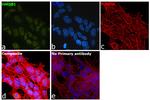
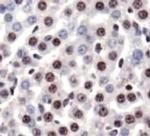
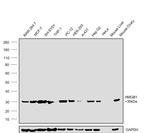
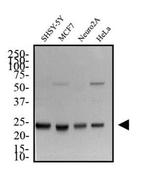
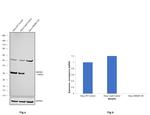
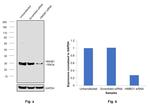

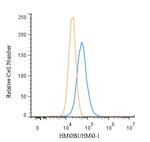
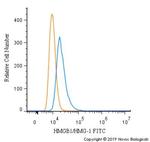

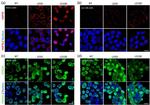
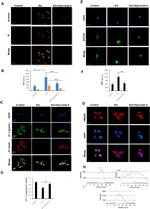
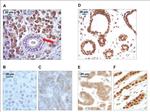
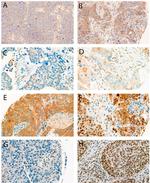
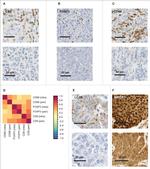
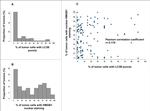
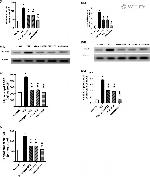
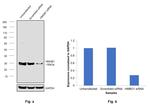
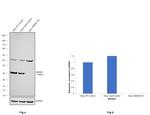
Product Details
PA1-16926
Species Reactivity
Published species
Host/Isotype
Class
Type
Immunogen
Conjugate
Form
Concentration
Purification
Storage buffer
Contains
Storage conditions
Shipping conditions
RRID
Product Specific Information
This antibody is expected to cross react with porcine, equine and rabbit samples based on 100% sequence homology.
Suggested positive control: Hela whole cell extract, antigen standard for HMGB1 (transient overexpression lysate).
Target Information
HMGB1 (High-mobility group box-1) protein was originally described as a nuclear non-histone DNA binding chromosomal protein. However, recent studies indicate that damaged, necrotic cells liberate HMGB1 into the extracellular milieu where it functions as a proinflammatory cytokine. Mouse HMGB1 is expressed as a 215 amino acid single chain polypeptide containing three domains: two tandem-linked positively charged DNA-binding domains (HMG box A, aa 9-79; and box B, aa 89-162), and a negatively charged 30 aa C-terminal acidic tail region. Residues 28 - 44 and 180 - 185 contain a nuclear localization signal (NLS). The cytokine activity of HMGB1 is contained in the B box, while the A box is associated with the helix-loop-helix domain of transcription factors. HMGB1 acts both as an inflammatory mediator that promotes monocyte migration and cytokine secretion, as well as a mediator of T cell-dendritic cell interaction. HMGB1 is secreted and acts to transduce cellular signals through its high affinity receptor, RAGE and possibly, TLR2 and TLR4. HMGB1 is highly conserved and ubiquitous in the nuclei and cytoplasm of nearly all cell types, is a necessary and sufficient mediator of inflammation during sterile and infection-associated responses. HMGB1 also act as DNA nuclear binding protein that has recently been shown to be an early trigger of sterile inflammation in animal models of trauma-hemorrhage via the activation of the Toll-like receptor 4 (TLR4) and the receptor for the advanced glycation endproducts (RAGE). Moreover, HMGB1 is reported that the level of HMGB1 is elevated during sterile tissue injury, infection, lethal endotoxemia or sepsis, collagen-induced arthritis, and ischemia-reperfusion induced tissue injury.
For Research Use Only. Not for use in diagnostic procedures. Not for resale without express authorization.
Bioinformatics
Protein Aliases: Amphoterin; Amphoterin antibody; DKFZp686A04236; Heparin-binding protein p30; high mobility group 1; High mobility group protein 1; High mobility group protein B1; high-mobility group (nonhistone chromosomal) protein 1; high-mobility group box 1; high-mobility-group protein; HMG-1; HMG3 antibody; hmgb 1; hmgb-1; HMGB1; RP11-550P23.1; Sulfoglucuronyl carbohydrate binding protein; unnamed protein product
Gene Aliases: Ac2-008; amphoterin; DEF; HMG-1; HMG1; HMG3; HMGB1; p30; SBP-1
UniProt ID: (Human) P09429, (Bovine) P10103, (Dog) Q6YKA4, (Rat) P63159, (Mouse) P63158
Entrez Gene ID: (Human) 3146, (Rabbit) 100328641, (Bovine) 282691, (Sheep) 101112071, (Dog) 403170, (Rat) 25459, (Mouse) 15289

Performance Guarantee
If an Invitrogen™ antibody doesn't perform as described on our website or datasheet,we'll replace the product at no cost to you, or provide you with a credit for a future purchase.*
Learn more
We're here to help
Get expert recommendations for common problems or connect directly with an on staff expert for technical assistance related to applications, equipment and general product use.
Contact tech support
